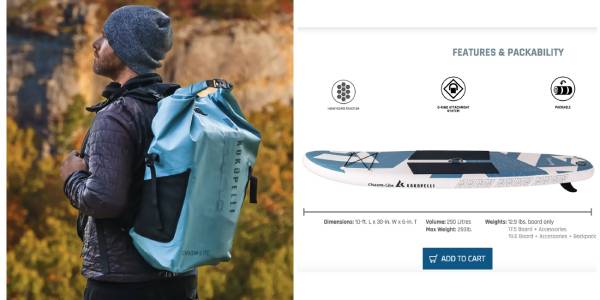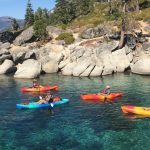It is essential to give a thorough examination when purchasing a pre-owned canoe. Potential customers should conduct a test of the boat in the water and request a record of the boat from the vendor.
Having an understanding of canoes, the price they were initially purchased for, and their reduced worth would also increase one’s assurance when making a purchase.
Know the Type of Canoeing You’ll Be Doing
It is essential to begin by taking this into account since it forms the basis of all other factors that you must consider when looking for a canoe. Consider whether you need to portage on extended wilderness excursions.
Should we bring the Minn Kota Endura Max to our cottage and use it with one of our canoes? Different types of canoeing excursions necessitate distinct vessels.
A Royalex or T-Formex canoe with plenty of rocker is needed for white water adventures, in order to guarantee good maneuverability and durability. Meanwhile, if you are going on a lake expedition, opt for a canoe that is long and lightweight, but with minimal rocker so it will move steadily in a lake.
Employing a canoe outside of its normal conditions can cause inconvenience, or even have disastrous consequences.
It is a good idea to consider the amount of cargo space and the maximum weight load for a canoe when deciding on the kind of canoeing to be done. We have an extensive article to help you!
How Much Can My Canoe Hold?
This article will explain how many pounds of gear each canoe ranging in size from 13 feet to 20 feet can handle!
Canoe Designs and Materials in BRIEF
To summarize quickly, this is the information you should be aware of regarding canoe materials;
Aluminum is highly resistant to damage and can withstand accidental impact and mistreatment. It’s great for kids and cottages. It’s also relatively inexpensive.
Despite its weight, this material does not produce an ergonomically efficient end result in a body of water, nor does it provide an opportunity to merge with the natural environment due to its noisiness and clumsiness.
Wood is both aesthetically pleasing and classic, yet it possesses numerous drawbacks. Wooden canoes can deteriorate if not kept indoors. If they are not kept in a place where the temperature is regulated, they can become distorted.
Know What Questions to Ask the Seller
This is a compilation of issues I want to query the seller regarding and why I need the answers.
a) How old is this canoe?
It is beneficial to be aware of how old and what kind of story the canoe has. It will provide you with a much clearer understanding of the initial and present worth of the vessel. If they are not certain of the age or background, you can attempt to locate the age of construction or a production batch with the hull recognition number if you contact the maker.
b) How was this canoe stored?
This is an important question for several reasons. Examining the present state of the canoe (particularly if you are not able to observe it directly and are communicating via telephone or message prior to your visit) should provide you with a better picture of its condition.
It may also reveal the current owner’s commitment towards preserving their property.
It is possible that additional surprises may await you if the canoe has been kept outside, and even moreso if it has been left exposed to the elements or covered with a tarp without any blockage between the tarp and the canoe.
This suggests that there could be mold or mildew due to the absence of air circulation between the canoe and the tarp.
Did the canoe hang from the grips or a seat? That might signal some warping to be aware of.
c) Why are you selling this canoe?
The seller might not be forthcoming with the information you seek, and if they are not, that could be indicative of a problem. He desires to sell it for the same reasons that you would not be interested in purchasing it!
d) How much has the canoe been used since you bought it?
If the canoe has seen plenty of action, this could mean that its owner is an avid enthusiast who looks after it carefully, or that he has been negligently careless with how he has treated it. Examine the boat and rely on your instinct when making your decision.
e) Have you done any repairs on it?
This can tell you if the holder is devoted to their trade or if it wasn’t used much, so there wasn’t any cause for fixing it. You would need to think about how much and how intensely the canoe was utilized or mishandled if there were several fixes.
f) Was the canoe used in salt water?
Many times failing to rinse after using saltwater can cause oxidation or, more commonly, a buildup of minerals and deposits.
Learn About Depreciation and How it Affects Your Purchase
As soon as a canoe bought from a store is hooked up to a car and transported home, its resale value goes down.
Generally, a high-grade canoe is likely to decrease in value by up to 30% within the first 1-3 years, depending on its upkeep and usage. The less it is deployed, the higher it will retain its value, and it might not be reduced more than 30% in value for up to five years or more.
After about ten years, the cost of the canoe will decrease to one third of the original cost and remain at that level unless it is neglected and deteriorates significantly.
Calculating depreciation can be complex, and the present value of a canoe depends on factors such as its condition, brand, and material. If you want to know about the price range of different canoe models, whether they are new or used, you can refer to THIS ARTICLE for an overview.
Take the Canoe on the Water for a Test Run
Here’s where things can get a little tricky. Prior to getting to the vendor’s spot, it’s beneficial to figure out how this section of the assessment is going to take place. When communicating before your visit, you should see if it’s feasible to splash the canoe with some water so you can have a better understanding of it.
There is a good chance that you will gain ownership of the canoe from an individual who resides far from any lake or river. In addition, even if there was a body of water close by, the idea of you removing someone else’s canoe without providing any compensation would be too much for most sellers.
If you shop from a retailer specializing in outdoor gear, the situation is different as they likely locate close to some body of water so they think you should try it out.
You need to trust your intuition and take a step back to view the entire situation. If the boat is of high quality, is a well-known brand, the vendor appears to be trustworthy, and the cost is fair, it could be worth purchasing it without doing a trial in water.
I acquired my previous Kevlar Evergreen Prospector canoe in this manner.
Know what to do if you can’t take it on the water
At times, you may not have the chance to take the canoe out on the water for a test, so you will have to make your decision while inspecting it at either the home of the seller or in a store. If you are in this type of situation, I suggest doing this before inspecting (go to item #9) or doing them at the same time.
- Portage the canoe around the yard or parking lot to get an idea of yoke comfort and balance
- Ask the owner if you can gently sit in the bow and stern seats to get a basic feel for it and check for sturdiness
- Bring a set of tripping bags (barrels, dry bags, etc.) to see how well they sit in the canoe
Best Family Canoe Buying Guide
Canoes come in different shapes, sizes, and styles. You should find a canoe that meets all of your family’s requirements and will help ensure a pleasant and secure experience while canoeing.
Stability
Children frequently begin their exploration of the water by using family canoes. It is often found that the parents are going out onto the lake, having not done paddling since camp around two decades or longer in the past. A reliable canoe will provide assurance when in the water and make it possible to investigate remote areas away from the shore.
Canoes which are wide generally tend to show the most stability, with the flat-bottomed boats at the top when it comes to primary stability. This suggests that your canoe will be more secure when it’s flat and immobile, which makes it great for kids who are fond of playing around in the canoe or using it as a jumping-off spot.
Speed
It is important to consider having a decent maximum speed if you are intending on canoeing for a considerable distance. Canoes that move more slowly will labor through the water, which will not only be physically gruelling, but also dispiriting, especially for inexperienced paddlers.
Canoes that are more elongated and thin tend to be more propelled, while wider canoes provide more impediment. If you need a strong, quick canoe, it could possibly be a challenge; however, some trade-offs are possible and the perfect balance can be achieved.
These bigger canoes are able to sail more precisely in opposition to the breeze, making it simpler to stay on track in rough water and swells.
The more extended the canoe is, the more challenging it is to turn in a confined space. These vessels can be useful for lengthy trips across open water, however, those looking to venture down a tight river or tackle the rapids would be better served by a smaller, more maneuverable canoe, which is family-friendly.
Size and Weight
Most canoes range in size from 13 to 17 feet. As previously mentioned, the size of the boat will affect how quickly and how easily you can steer it when out on the water. However, there are further matters to contemplate concerning the magnitude.
The depth of your canoe is also important. If your canoe is wide, it will be more challenging for people with shorter arms to paddle easily around the side. If you are looking for a way for your kids to join in, think about getting a canoe with a smaller number of sides.
Be aware, however, that these lower canoes are less resistant to splashes or waves entering them if you find yourself paddling in turbulent waters or down river.
Seating
Every person using a paddle should be given a place to sit. This does not only make the experience on the water pleasant for them. They have the opportunity to become involved in the activity of rowing, remain focused, and cultivate an appreciation for the game.
In some cases, two minors can occupy a single seat, while a guardian occupies the seat in the back. A three-person canoe can be an ideal option if you want to take adults as well as children together on the water.
As your children advance in their paddling skills, you may require an additional canoe to keep them busy and engaged.
Capacity
Canoes are tested to an upper capacity. This is the maximum amount of weight that can be carried without sinking. You should never fill the canoe more than 70% of its capacity so you can remain in prime performance. A canoe should never be filled with more than 700 lbs., even if its maximum capacity is 1000 lbs.
The total weight you are carrying in the canoe or kayak encompasses everyone in the boat, any apparel they are wearing, and all of the supplies you are bringing in the vessel. Keep in mind that the kids may become bigger in the near future when computing the total weight of all the paddlers.
How often will you go canoeing?
It is essential to think about this before you invest a large amount of cash in a canoe. Do you anticipate taking up canoeing on a full-time basis or will you just be doing it sporadically on summer days?
If you’re uncertain about how your children will react to canoeing, you can test it out by renting or borrowing a canoe for a time period before you commit to purchasing one. That way, you will be able to determine if they are enthusiastic about taking a boat ride. You should not purchase a top-of-the-line canoe if you plan to only keep it stored overhead in your garage.




